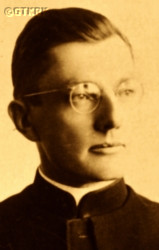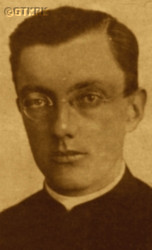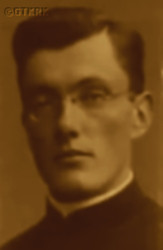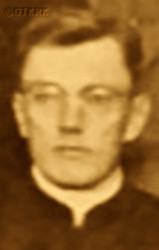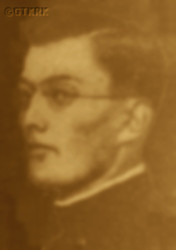Roman Catholic
St Sigismund parish
05-507 Słomczyn
85 Wiślana Str.
Konstancin deanery
Warsaw archdiocese, Poland
full list:
displayClick to display full list

searchClick to search full list by categories
wyświetlKliknij by wyświetlić pełną listę po polsku

szukajKliknij by przeszukać listę wg kategorii po polsku

Martyrology of the clergy — Poland
XX century (1914 – 1989)
personal data
religious status
Servant of God
surname
BROKS
forename(s)
Louis (pl. Alojzy)
function
diocesan priest
creed
Latin (Roman Catholic) Church RCmore on
en.wikipedia.org
[access: 2014.09.21]
diocese / province
Riga archdiocesemore on
en.wikipedia.org
[access: 2013.05.19]
academic distinctions
Doctor of Theology
honorary titles
Order of the Three Stars (Latvia) — 4th classmore on
en.wikipedia.org
[access: 2021.05.20]
(16.11.1938)
nationality
Latvian
date and place
of death
1943

KL Neuengammeconcentration camp
today: Hamburg, Hamburg state, Germany
more on
en.wikipedia.org
[access: 2022.01.09]
alt. dates and places
of death
28.04.1944
(Latvia territory)today: Latvia
more on
en.wikipedia.org
[access: 2023.11.24]
KL Stutthofconcentration camp
today: Sztutowo, Sztutowo gm., Nowy Dwór Gdański pov., Pomerania voiv., Poland
more on
en.wikipedia.org
[access: 2022.01.09]
details of death
After German and Russian invasion of Poland in 09.1939 and start of the II World, after annexation in 05.1940 of Latvia by Russia, after closure by the Russians of both gymnasiums in Anglona and Jaunaglona (c. 13 km away from each other), which was the principal of, resided in Courland, a Baltic region of Latvia, in Lēnas village.
After German attack in 06.1941 of their erstwhile ally, Russians, and start of German occupation, returned to Aglona.
There witnessed mass murders committed by German SS Einsatzgruppen on mental hospital patients and children (544 to 1,000 victims), perpetrated as part of genocidal «Aktion T4» program.
On 02.12.1941 (according to some sources on 23.08.1941) at Aglona church made a sermon focused on „Thou shell not kill” commandment.
Following that in 12.1941 arrested by the Germans for the first time.
Released however soon after, in the spring of 1942.
On c. 24.05.1942 arrested a second time — prob. after an attempt to save a Jewish family whom he took Riga and hid.
Held in Daugavpils, and then in central prison in Riga.
Fate thereafter uncertain.
Prob. transported to the German concentration camp KL Stutthof and next to KL Neuengamme concentration camp where perished.
alt. details of death
According to some sources murdered in Latvia.
According to yet another perished in KL Stutthof concentration camp.
cause of death
extermination
perpetrators
Germans
sites and events
KL NeuengammeClick to display the description, KL StutthofClick to display the description, Ribbentrop‐MolotovClick to display the description, Pius XI's encyclicalsClick to display the description
date and place
of birth
01.03.1898

Sileniekitoday: Varakļāni pog., Varakļāni mun., Latvia
more on
lv.wikipedia.org
[access: 2022.06.29]
presbyter (holy orders)
ordination
1921

positions held
1941 – 1942
supernumerary professor — Rigatoday: Riga city mun., Latvia
more on
en.wikipedia.org
[access: 2020.07.31] ⋄ Department of Catholic Theology, Universitas Latviensis (Eng. University of Latvia)
1941 – 1942
director — Aglonatoday: Aglona pog., Preiļi mun., Latvia
more on
en.wikipedia.org
[access: 2022.06.29] ⋄ Catholic gymnasium ⋄ Assumption of the Blessed Virgin Mary RC parish ⋄ Dünaburg suburbsdeanery name
today: Daugavpils urban mun., Latvia
more on
en.wikipedia.org
[access: 2020.07.31] RC deanery
1941 – 1942
director — Jaunaglonatoday: Aglona pog., Preiļi mun., Latvia
more on
lv.wikipedia.org
[access: 2022.06.29] ⋄ gymnasium for Women
1940 – 1941
priest — Lēnastoday: Nīkrāce pog., Kuldiga mun., Latvia
more on
lv.wikipedia.org
[access: 2024.05.08] ⋄ Holy Trinity RC parish
1929 – 1940
director — Aglonatoday: Aglona pog., Preiļi mun., Latvia
more on
en.wikipedia.org
[access: 2022.06.29] ⋄ Catholic gymnasium ⋄ Assumption of the Blessed Virgin Mary RC parish ⋄ Dünaburg suburbsdeanery name
today: Daugavpils urban mun., Latvia
more on
en.wikipedia.org
[access: 2020.07.31] RC deanery
1929 – 1940
director — Jaunaglonatoday: Aglona pog., Preiļi mun., Latvia
more on
lv.wikipedia.org
[access: 2022.06.29] ⋄ gymnasium for Women
1932 – 1940
parish priest — Aglonatoday: Aglona pog., Preiļi mun., Latvia
more on
en.wikipedia.org
[access: 2022.06.29] ⋄ Assumption of the Blessed Virgin Mary RC parish — also: 1934‐1940 member of Lat. „Aizsargi” (pl. „Defenders”), the Latvian volunteer paramilitary territorial defense formation, including, i.a. in 1936, chaplain of the battalion (II) of the 18th „Aizsargi” Regiment from Daugavpils
1925 – 1929
teacher — Aglonatoday: Aglona pog., Preiļi mun., Latvia
more on
en.wikipedia.org
[access: 2022.06.29] ⋄ Catholic gymnasium ⋄ Assumption of the Blessed Virgin Mary RC parish ⋄ Dünaburg suburbsdeanery name
today: Daugavpils urban mun., Latvia
more on
en.wikipedia.org
[access: 2020.07.31] RC deanery — also: inspector
1925 – 1929
teacher — Jaunaglonatoday: Aglona pog., Preiļi mun., Latvia
more on
lv.wikipedia.org
[access: 2022.06.29] ⋄ gymnasium for Women — also: inspector
c. 1925
vicar — Viļakaform.: Marienhauz
today: Viļaka pog., Balvi mun., Latvia
more on
en.wikipedia.org
[access: 2022.02.15] ⋄ Sacred Heart of Jesus RC parish
till 1925
PhD student — Viennatoday: Vienna state, Austria
more on
en.wikipedia.org
[access: 2020.07.31] ⋄ theology, Alma Mater Rudolphina Vindobonensis (Eng. University of Vienna), i.e. Rudolphina
1921
student — Aglonatoday: Aglona pog., Preiļi mun., Latvia
more on
en.wikipedia.org
[access: 2022.06.29] ⋄ philosophy and theology, Theological Seminary
1920 – 1921
student — Vilniustoday: Vilnius city dist., Vilnius Cou., Lithuania
more on
en.wikipedia.org
[access: 2022.01.06] ⋄ philosophy and theology, Theological Seminary
1916 – 1918
student — Sankt Petersburgtoday: Saint Petersburg city, Russia
more on
en.wikipedia.org
[access: 2020.07.31] ⋄ philosophy and theology, Metropolitan Theological Seminary
translator of the Holy Scriptures of the New Testament into Latvian (more precise into Latgalian, Latvian dialect), published as Lat. „Svātī roksti. Jezus Kristus Evangelijs und Apostolu derbi” (Eng. „Visit the church. The Gospel of Jesus Christ and the Acts of the Apostles”), 1933, and Lat. „Apostols vystules i apokalypsis” (Eng. „Epistles and Apocalypse”), 1937; author of the prayer book Lat. „Paleigs ticeigūs dvēselem” (pl. „He will help the believing souls”), Aglona 1934, collection of songs Lat. „Stuņdaiņas dzīsmes” (Eng. „Song of Songs”), editor of magazines 1928‐1931 Lat. „Draugs” (Eng. „Friend”) and 1931‐1933 Lat. „Zīdūnis”
sites and events
descriptions
KL Neuengamme: German Germ. Konzentrationslager (Eng. concentration camp) KL, initially fillial to KL Sachsenhausen, from 1940 independent. Prisoners were used as slave labor — till 1942 in the production of bricks (e.g. extraction and transport of clay), and then in various German private arms factories. The Germ. „Vernichtung durch Arbeit” (Eng. „extermination through work”) principle was applied to prisoners, as a result of which, out of over 100,400 prisoners 42,900‐55,000, according to various estimates, perished. Some were murdered during tests with Cyklon B gas, which was next used for the genocide of Jews in KL Auschwitz. On 18.04.1945, the evacuation of the camp began. The Germans dragged the survivors in the so‐called „death marches” to other camps, but some locked in a few ships standing in the roadstead of the port in Hamburg. Two of them were bombed by the Allies and most of the prisoners perished. (more on: pl.wikipedia.orgClick to attempt to display webpage
[access: 2012.11.23])
KL Stutthof: In German Germ. Konzentrationslager (Eng. concentration camp) KL Stutthof (then in Eastern Prussian belonging to Germany, today: Sztutowo village) concentration camp, that Germans started to build on 02.09.1939, a day after German invasion of Poland and start of the World War II, Germans held c. 110,000‐127,000 prisoners from 28 countries, including 49,000 women and children. C. 65,000 victims were murdered and exterminated. In the period of 25.01‐27.04.1945 in the face of approaching Russian army Germans evacuated the camp. When on 09.05.1945 Russians soldiers entered the camp only 100 prisoners were still there. In an initial period (1939‐1940) Polish Catholic priests from Pomerania were held captive there before being transported to KL Dachau concentration camp. Some of them were murdered in KL Stutthof or vicinity (for instance in Stegna forest). Also later some Catholic priests were held in KL Stutthof. (more on: stutthof.orgClick to attempt to display webpage
[access: 2018.11.18], en.wikipedia.orgClick to attempt to display webpage
[access: 2013.07.06])
Ribbentrop‐Molotov: Genocidal Russian‐German alliance pact between Russian leader Joseph Stalin and German leader Adolf Hitler signed on 23.08.1939 in Moscow by respective foreign ministers, Mr. Vyacheslav Molotov for Russia and Joachim von Ribbentrop for Germany. The pact sanctioned and was the direct cause of joint Russian and German invasion of Poland and the outbreak of the World War II in 09.1939. In a political sense, the pact was an attempt to restore the status quo ante before 1914, with one exception, namely the „commercial” exchange of the so‐called „Kingdom of Poland”, which in 1914 was part of the Russian Empire, fore Eastern Galicia (today's western Ukraine), in 1914 belonging to the Austro‐Hungarian Empire. Galicia, including Lviv, was to be taken over by the Russians, the „Kingdom of Poland” — under the name of the General Governorate — Germany. The resultant „war was one of the greatest calamities and dramas of humanity in history, for two atheistic and anti‐Christian ideologies — national and international socialism — rejected God and His fifth Decalogue commandment: Thou shall not kill!” (Abp Stanislav Gądecki, 01.09.2019). The decisions taken — backed up by the betrayal of the formal allies of Poland, France and Germany, which on 12.09.1939, at a joint conference in Abbeville, decided not to provide aid to attacked Poland and not to take military action against Germany (a clear breach of treaty obligations with Poland) — were on 28.09.1939 slightly altered and made more precise when a treaty on „German‐Russian boundaries and friendship” was agreed by the same murderous signatories. One of its findings was establishment of spheres of influence in Central and Eastern Europe and in consequence IV partition of Poland. In one of its secret annexes agreed, that: „the Signatories will not tolerate on its respective territories any Polish propaganda that affects the territory of the other Side. On their respective territories they will suppress all such propaganda and inform each other of the measures taken to accomplish it”. The agreements resulted in a series of meeting between two genocidal organization representing both sides — German Gestapo and Russian NKVD when coordination of efforts to exterminate Polish intelligentsia and Polish leading classes (in Germany called «Intelligenzaktion», in Russia took the form of Katyń massacres) where discussed. Resulted in deaths of hundreds of thousands of Polish intelligentsia, including thousands of priests presented here, and tens of millions of ordinary people,. The results of this Russian‐German pact lasted till 1989 and are still in evidence even today. (more on: en.wikipedia.orgClick to attempt to display webpage
[access: 2015.09.30])
Pius XI's encyclicals: Facing the creation of two totalitarian systems in Europe, which seemed to compete with each other, though there were more similarities than contradictions between them, Pope Pius XI issued in 03.1937 (within 5 days) two encyclicals. In the „Mit brennender Sorge” (Eng. „With Burning Concern”) published on 14.03.1938, condemned the national socialism prevailing in Germany. The Pope wrote: „Whoever, following the old Germanic‐pre‐Christian beliefs, puts various impersonal fate in the place of a personal God, denies the wisdom of God and Providence […], whoever exalts earthly values: race or nation, or state, or state system, representatives of state power or other fundamental values of human society, […] and makes them the highest standard of all values, including religious ones, and idolizes them, this one […] is far from true faith in God and from a worldview corresponding to such faith”. On 19.03.1937, published „Divini Redemptoris” (Eng. „Divine Redeemer”), in which criticized Russian communism, dialectical materialism and the class struggle theory. The Pope wrote: „Communism deprives man of freedom, and therefore the spiritual basis of all life norms. It deprives the human person of all his dignity and any moral support with which he could resist the onslaught of blind passions […] This is the new gospel that Bolshevik and godless communism preaches as a message of salvation and redemption of humanity”… Pius XI demanded that the established human law be subjected to the natural law of God , recommended the implementation of the ideal of a Christian state and society, and called on Catholics to resist. Two years later, National Socialist Germany and Communist Russia came together and started World War II. (more on: www.vatican.vaClick to attempt to display webpage
[access: 2023.05.28], www.vatican.vaClick to attempt to display webpage
[access: 2023.05.28])
sources
personal:
www.varaklani.lvClick to attempt to display webpage
[access: 2018.09.02], literatura.lvClick to attempt to display webpage
[access: 2018.09.02], www.literatura.lvClick to attempt to display webpage
[access: 2024.05.08], katolis.lvClick to attempt to display webpage
[access: 2018.09.02], latgalesdati.du.lvClick to attempt to display webpage
[access: 2024.05.09], newsaints.faithweb.comClick to attempt to display webpage
[access: 2024.05.08]
original images:
www.varaklani.lvClick to attempt to display webpage
[access: 2018.09.02], literatura.lvClick to attempt to display webpage
[access: 2018.09.02], timenote.infoClick to attempt to display webpage
[access: 2018.09.02], latgalesdati.du.lvClick to attempt to display webpage
[access: 2018.09.02], okupacijasmuzejs.lvClick to attempt to display webpage
[access: 2018.09.02], okupacijasmuzejs.lvClick to attempt to display webpage
[access: 2018.09.02]
LETTER to CUSTODIAN/ADMINISTRATOR
If you have an Email client on your communicator/computer — such as Mozilla Thunderbird, Windows Mail or Microsoft Outlook, described at WikipediaPatrz:
en.wikipedia.org, among others — try the link below, please:
LETTER to CUSTODIAN/ADMINISTRATORClick and try to call your own Email client
If however you do not run such a client or the above link is not active please send an email to the Custodian/Administrator using your account — in your customary email/correspondence engine — at the following address:

giving the following as the subject:
MARTYROLOGY: BROKS Louis
To return to the biography press below:
 Click to return to biography
Click to return to biography








